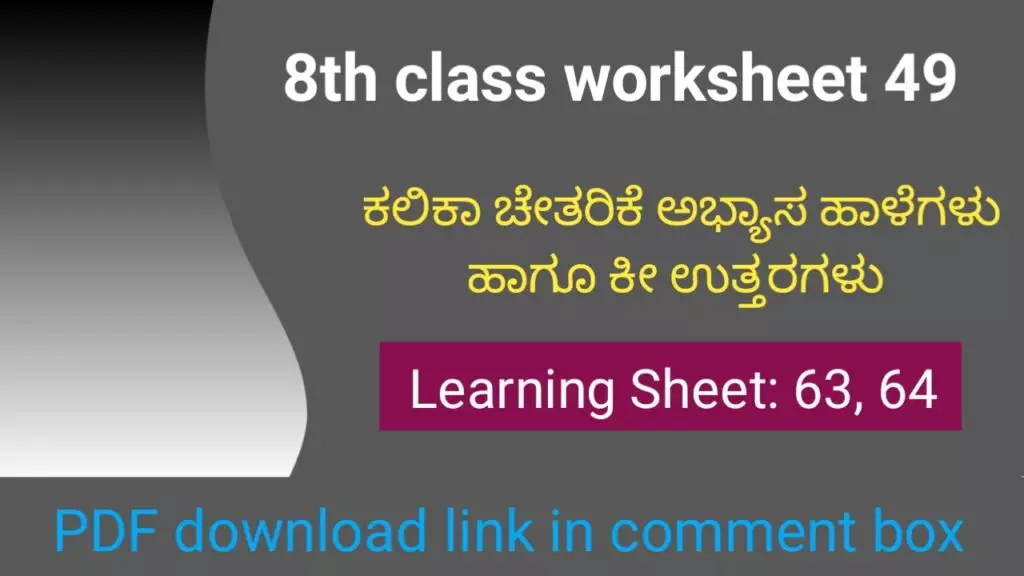
Kalika Chetarike activity 49 for 8th class students. Activity worksheet for 8th standard students. Key answer for activity 2 and 3.1.
In this post we are discussing learning out come and rubrics for Kalika chetarike. Activity worksheet and key answer. 8th class learning out come and rubrics for Kalika chetarike. 8th class Kalika Chetarike English.
To get more video notes for 8th class visit our YouTube channel. This channel is very useful for 8th standard exam preparation.
Download worksheet with key answer
8th class Kalika Chetarike English
LEARNING SHEET 63
Activity 2:
An outline of a story is given. Complete the story by supplying required words and phrases. Also give a title and the moral of the story.
A poor woodcutter ‘s axe slipped and fell into a river—-a god heard him cry and wanted to help him—–he dived into the river and brought a gold axe for him——the honest woodcutter did not take this axe——the god again went down into the river and brought up a silver axe, which the honest woodcutter refused to accept——the god was very pleased and gave him his own axe as well as the gold and silver axes.
Answer:
An Honest Woodcutter
Once there lived a poor woodcutter. He used to cut trees in the woods. One day he was cutting wood on the bank of a river. His axe fell down into the river. The river was deep. He could not take his axe out. He sat on the bank and began to weep.
Mercury, the god of water appeared. He asked the reason of his weeping. The woodcutter told the whole story. Mercury dived into the water and brought a golden axe. The woodcutter refused to take it. Mercury again dived and brought a silver axe. The woodcutter did not take it either. Then he brought an iron axe. The woodcutter took it gladly. Mercury was much pleased. He rewarded the woodcutter with the other two axes.
Moral: Honesty is the best policy.
LEARNING SHEET 64
Activity 3.1:
Write a note on the following Gender Sensitivity Issues.
1) Vulnerability to poverty
2) Discrimination for employment and desires for higher positions
3) Unfavourable treatment for healthcare
4) Limitations and hindrance to acquire further education
5) Hindrance for political career which renders them invisible and mere follower.
8th class Activity worksheet and key answer
1) Vulnerability to poverty
The ongoing social issue of both all people suffering from poverty worldwide is gender and poverty. Women are at the heart of poverty as they take care of families and of many homework, and it is focused on the burden of development and agriculture.
Women and poverty is an internationally recognized agenda which dominates the international politics agendas. The result of the poverty on women is usually associated with discrimination in the labour force, cases of prejudicial gender biases which range from the equal allocation of resources in the community as a whole to home predominance.
Cases of gender differences regarding wages is also another factor resulting in poverty as a social factor with women experiencing disparities in workplaces as well as property ownership which make them vulnerable to the face of poverty.
Economic and social wellbeing plays a crucial role in the relationship between women and poverty. For instance, micro-credit schemes in the global south promote the idea of “women empowerment,” but often place women in disadvantaged situations. These women frequently struggle to repay loans, which increases their vulnerability to poverty.
In this context, it’s essential to examine how these financial initiatives can lead to unintended consequences, such as increased debt and dependency, rather than genuine empowerment. This situation highlights the need for more supportive policies that address the root causes of poverty and promote sustainable economic growth for women.
Kalika Chetarike worksheet
For more detailed insights into micro-credit schemes and their impact on women, consider exploring resources from organizations like the World Bank or UN Women.
In conclusion, gender disparity is the greatest cause of poverty among women with discrimination in multiple platforms despite their significant roles in taking care of families and balancing this with an economic contribution towards growth.
Watch this video for the explanation of Kalika Chetarike activity 49 for 8th class students.